Second release: Modelsvit 1/48 P-51H Mustang
The Airplane:
The original Allison-powered Mustang was a lightweight fighter with excellent handling capability. North American was aware of this during the aircraft's original wartime development, and put considerable effort into trying to come up with a lightweight Mustang that gave the maneuverability of the earlier models with the altitude performance and range of the later models. The XP-51F and XP-51G were the result. Using the same Merlin V-1650-7 engine as the P-51D, the loaded weight of the airplane was reduced to 9,060 pounds - as compared to a loaded weight of 10,100 pounds for the P-51D. This was accomplished through simplification of the structure, the deletion of some equipment, and the use of new materials such as plastics, while aerodynamics were improved with a longer bubble canopy. The net result was a savings of 1,100 pounds and a top speed of 466 mph. The XP-51G was fitted with the Merlin 145 engine and achieved a top of 472 mph.
Development of the lightweight Mustang resulted in the P-51H, which entered production towards the end of 1944. Powered by a Packard-Merlin V-1650-9 delivering a maximum 2,218 horsepower (as opposed to the maximum 1,695 horsepower of the P-51D), the maximum range of 1,000 miles on internal fuel could be extended to 1,500 miles with two 110-gallon drop tanks. The P-51H had a shorter “bubble” canopy than the XP-51F/G, and a full 6-gun armament, the result was that the overload weight of 10,500 pounds was only a few hundred less than the P-51D. Nevertheless, it was the fastest production P-51, with a top speed of 487 mph. 1,445 P-51Hs were ordered in January 1945, but the end of the war in August brought production to a halt with a total of 555 aircraft.
The P-51H equipped a few regular USAAF units in the immediate postwar years, including the Mustang-phobic 56th Fighter
Group on their arrival back at Selfridge Field and during a deployment to Alaska, before it along with the P-47N, equipped the postwar Air National Guard when jets replaced propeller- driven fighters in the U.S. Air Force. The V-1650-9 Merlin was temperamental and units equipped with the P-51H seldom experienced more than 50% availability. This more than anything else was responsible for the P-51H not being called to active duty during the Korean War.
Claude J. Crenshaw, a 7-victory ace with the 359th Fighter Group in World War II was a member of the 14th Fighter Group from 1947-49, which had re-equipped with the P-51H after being inactivated in Italy at the end of World War II. Crenshaw gave his P-51H the same name as his P-51D, “Louisiana Heatwave” and it also carried his World War II score of 7 aerial victories and four “ground kills.”
The Kit:
In 1999, Classic Airframes released a P-51H that was one of the more difficult kits from a company famous for “difficult kits.” It took doing two for me to get one that looked like the prototype. The other was released by HiPM, a company whose products were it finally resulted in them going out of business. The only thing I can recall of that kit was that it vaguely resembled a P-51H, and was one of the few plastic kits I have ever built that not only was thrown against a wall but was stomped into its component atoms.
Modelsvit, a Ukrainian producer of high-quality short-run kits, released their P-51H in January 2020. This kit effectively replaces all other kits of this airplane. The kit parts have delicate surface detail that demonstratedsModelsvit paid attention to what Eduard did with their P-51D. This second release, which came out earlier this year, is the same kit with different markings, for two postwar units in the period when the USAAF became the independent USAF, from the 56th and 57th Fighter Groups when they were part of the Alaska Air Command. There is also a F-51H from the New York ANG in 1953 and an F-51H that was a target tug used by the Pennsylvania ANG in 1954, painted red.
Construction:
The most important thing I to remember is this is a high-end LIMITED RUN KIT. It does look like the Eduard kit when assembled in terms of nice detail, but if you think it's the Eduard kit while working on it, you will be sorely disappointed and unsuccessful. Remember the rule: test fit three times before gluing once. If you do, and take care in assembly, you too can have a model that has minimum filler on it - I only had to apply some CA glue to the centerline seam in the radiator scoop.
When assembling the cockpit, the major sub-assembly, I first attached all the small parts to the larger parts (sidewalls and floor), then painted everything still on the sprue. Modelsvit wants you to then assemble the cockpit completely and glue it to a fuselage half, which I did with this kit. As designed, the seat and armor backing will sit too low. I attached the seat to the armor backing and then attached that little sub-assembly to the rear bulkhead about 1/16 inch higher than the attachment points would have it. This put it right, according to photos. Everything came together with perfect fit. I fitted the radioator exhaust and rtail wheel well in the right fuselage half then glued the fuselage together/
The other major sub-assembly is the wing. I scraped down the walls of the gear well so they fit inside the wing. Getting the wing sub-assembly to fit properly will lead to you being able to attach it to the fuselage without filler at the upper wing-fuselage joint.
The horizontal stabilizers fit well – be sure to check alignment to be certain they are level. The elevators as designed fit in the neutral position.
The antennas are butt-fitted and that's not good. I dug out a little bit at their attachment points to give them a little “snuggle space” and glued them in. Be careful, they're going to be easy to knock off whatever you do.
The canopy is thick but clear and offers both closed and open options. I did the open option on the first kit, so decided to do it closed this time. I “futured” the canopy, which got rid of the slight distortion. I needed to sand back the front edge of the canooy so the windscreen would fit properly. Test fit three times before gluing once.
Painting:
I painted the yellow wint and stabilizer tips and the rudder tip and strip, then masked them off. I painted the airframe with Tamiya XF-1 Flat Black, after which I masked off the anti-glare on the upper nose.. The NMF was done with Vallejo metallics. I used Dull Aluminum for the wings which were painted with aluminum lacquer. I used Semi-Matte Aluminum for the wing fuel tank are on the lower wing surface. The rest of the airframe was painted with Aluminum. I did the panels around the exhausts and the area of the radiator with a mixture of Duraluminum and Aluminum.
Decals:
I used the kit decals for the insignia and the serial number, which I pieced together from the kit sheet. I also used the kit decals for the wing walk and no-step and stencils. I used the “Louisiana Heatwave” decals from the Eduard P-51D-5 kit. I had to slice the letters individually so they could be posed differently than they were on the P-51D.
Final Assembly:
I assembled and attached the main gear legs. These are designed to fit with the proper forward slant of the gear legs when they are positioned properly. I then attached the prop and called things done.
Overall:
Once finished, if you've taken your time with assembly and painting, you can sit this model next to an Eduard P-51D and people would think the two kits came from the same place. Just remember that they didn't, and that you're dealing with a limited run kit, no matter how high-end it is, and all will be well.
This is still one of the nicest Mustang kits I've done. Recommended for those Mustang Fan(atics)with experience in assembling limited-run kits. Take care and you will have a great model to add to your Mustang collection.

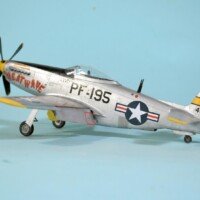
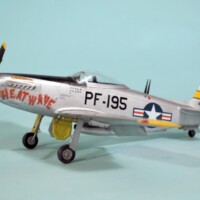
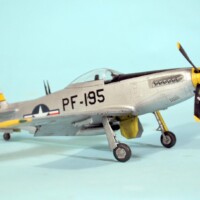
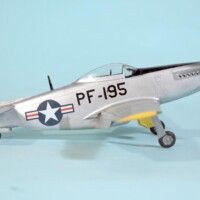
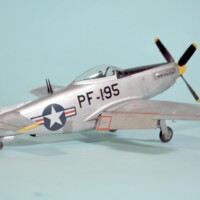
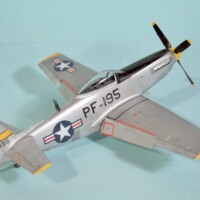
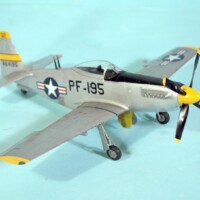
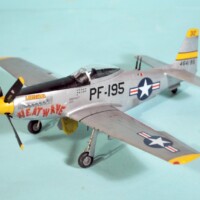
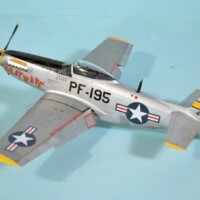
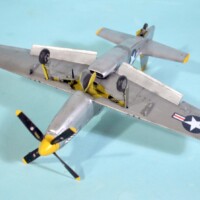
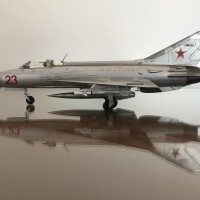
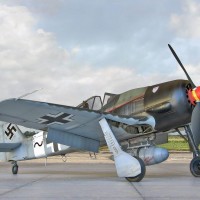
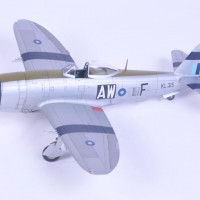
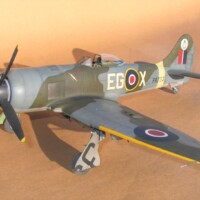
Excellent result Tom and interesting history on a variant of the P-51 I wasn't aware of.
Another winner, Tom! Loved reading the story behind the -H version, as well as the final result!
Another gem, Tom @tcinla
The NMF did came out very nicely and with those yellow markings the scheme is well chosen.
Thanks for sharing the historical background and the building thread.
Beautiful bird. I like the care with which it was built. Definitely a beautiful piece for the collection.
Nice job, Tom
It's quite a good looking result.
What a lovely Mustang! Nice job on such a challenging kit.
Great result, Tom. That plane is growing on me.
Beauty
Good-looking Mustang!
Excellent! I did this one awhile back, agree that it blows the competition away!
Really beautiful work as always Mr. Cleaver. It looks like a really nice kit of the last of the Mustangs. I have never been a big fan of the H model, they have always looked a little goofy to me, maybe cartoonish. They have those little main gear wheels, there a little bulged in the area between the canopie and the lower air scoop. There just not as elegant looking as the earlier models. I understand the reasons why they looked the way they did, but I've never been a fan. In my opinion, (which means absolutely noththing) I think the real pinical of the P-51 line was the combat proven D/K model. I would however add this kit to my P-51 collection because of it being the last model in service with the USAAF and USAF. Thank you for another great review, and background history. 🙏👍
This looks great! Although, I have to agree with Clint, the H always looked a little goofy to me too. I remember making the old Aurora Mustang when I was very young and thinking, “This thing does not look right!” It wasn’t until I was older and more knowledgeable I realized it was a P-51H.
Tom Cleaver (@tcinla)
This looks very nice. I thoroughly enjoyed reading your article as well. I don't have an "H" model in "ye olde stash" and after looking at how nice yours turned out, this may change sometime in the future. Like you, I have been around numerous full sized Mustangs, and have had the opportunity to see the little details between the A-36, P-51B / C and the later D versions. However I have never seen an H model in real life.
Knowing there is a target tug version from the Pennsylvania ANG is a plus. I have a lot of family that live in the state. I think it would look different and very colorful in the display cabinet sitting next to my other completed Mustangs. Once again my wallet will take a hit for the team because of your excellent looking build and review.
I made sure to click on some of the various "like" buttons. Now maybe you can get cracking on your 1/48 scale ICM Ki-21 Sally. I'm looking forward to seeing and reading about it too.
Take care my friend and I hope you have a wonderful Christmas holiday.
You too, @lgardner (re: Christmas)
That turned out well, Tom @tcinla! 👏 I learned a lot of Mustang history from your article too! 👍
One thing to know about this kit that's in error: on the P-51H (unlike earlier Mustangs) the main landing gear doors retracted at the end of the gear cycle. So when the airplane is parked, engine off, the doors are up.
I'm sure Modelsvit used the restored H that used to be at Chanute, which has the doors extended.
When I built this kit, I didn't learn this until after I'd glued the upper and lower wings so it was a real chore to fix. I think it'd be a lot easier if you do this first.
1 attached image. Click to enlarge.
I had thought about doing that - the gear doors fit in the up position without any problem.